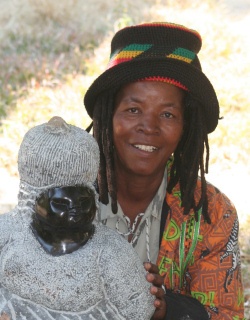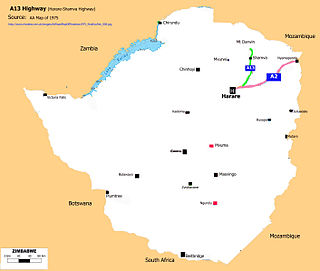Related Research Articles

Harare is the capital and most populous city of Zimbabwe. The city proper has an area of 960.6 km2 (371 mi2) and a population 2,123,132 in the 2012 census and an estimated 3,120,917 in its metropolitan area in 2019. Situated in north-eastern Zimbabwe in the country's Mashonaland region, Harare is a metropolitan province, which also incorporates the municipalities of Chitungwiza and Epworth. The city sits on a plateau at an elevation of 1,483 metres above sea level and its climate falls into the subtropical highland category.

Kirstenbosch is an important botanical garden nestled at the eastern foot of Table Mountain in Cape Town. The garden is one of 10 National Botanical Gardens covering five of South Africa's six different biomes and administered by the South African National Biodiversity Institute (SANBI). Prior to 1 September 2004, the institute was known as the National Botanical Institute.

The Bvumba Mountains or Vumba Mountains straddle the Zimbabwe-Mozambique border, and are situated some 10 km south east of Mutare. The Bvumba rise to Castle Beacon at 1,911 metres, and are, together with the Chimanimani Mountains to the south and Nyanga Mountains to the north, part of the Eastern Highlands of the Manicaland and adjacent Manica provinces. They are referred to as the "Mountains of the Mist", as so often the early morning starts with a mist which clears by mid-morning. Although lying mostly within Zimbabwe, the mountains extend north-eastward to Mount Vumba in Mozambique. They are capped by cool, green hills which shelter country hotels, a casino and golf course at the Leopard Rock Hotel and a Botanical Garden with one of the best views in Africa. The mountains are also known for their coffee plantations.
National Botanic(al) Garden(s) may refer to:

The Chapungu Sculpture Park is a sculpture park in Msasa, Harare, Zimbabwe, which displays the work of Zimbabwean stone sculptors. It was founded in 1970 by Roy Guthrie, who was instrumental in promoting the work of its sculptors worldwide. One way this was done was by exhibiting the sculptures in Botanical Gardens in a touring exhibition called "Chapungu: Custom and Legend — A Culture in Stone". The places visited include:
John Takawira was a Zimbabwean sculptor. The background to the sculptural movement of which he was a leading member is given in the article on Shona art.

Colleen Madamombe was a Zimbabwean sculptor working primarily in stone. Her work expresses themes of womanhood, motherhood, and tribal Matriarchy.

Agnes Nyanhongo is a Zimbabwean stone sculptor.
Epworth is a dormitory town in south-eastern Harare Province, Zimbabwe. Its population exploded in the late 1970s and 1980s as an informal settlement.

Chimanimani is a town in Zimbabwe.
Borrowdale is a residential suburb in the north of Harare, Zimbabwe, which ranks among the most affluent and prestigious residential areas in the country. It forms part of the Northeast suburbs of the city of Harare, with a population of 20,312 as of the Zimbabwe 2012 Census.
Alexandra Park is an affluent, leafy residential suburb in the north of Harare, Zimbabwe. The area was developed for serviceman and their families in the post-war years following World War II.

National Botanic Garden of Zimbabwe is situated about 4 km North of Harare City Centre in the suburb of Alexandra Park. It also houses the National Herbarium of Zimbabwe. The gardens have an area of almost 7 square kilometres. It was initially established as a recreation area in 1902. In 1962 it became the National Botanic Gardens under the direction of Prof. Hiram Wild. Half of the gardens are devoted to indigenous plants from Zimbabwe's woodlands and include most of the 750 species found in the country. Other areas contain plants typical to the African continent including rare and endangered species, as well as exotics from South America, India, Australia and the Far East. It contains 90% of the different ecological habitats in found in Zimbabwe.
Adam Madebe is a visual artist, frequently credited as one of Zimbabwe's most known sculptors working in metal. He lives and works in Johannesburg, South Africa.

A13 Highway is a busy road in Zimbabwe running from Enterprise Road, Harare to Shamva, Madziwa Mine and through to Gora Turn-off on the A11 Highway towards Wimbo Shrine, Mt Darwin.
Glen View is a high-density suburb in Harare, Zimbabwe. Nearby suburbs include Highfield, Waterfalls and Mbare. ZESA Harare Southern Region HQ is located in Glen View 1.
The La Rochelle Estate is a country estate owned by the National Trust Zimbabwe, situated in the Imbeza Valley in the Eastern Highlands of Zimbabwe close to the border with Mozambique and approximately 20 km from the city of Mutare. The site comprises approximately 108 ha.
Newlands is a low density, residential suburb located in eastern Harare, Zimbabwe.
Greenwood Park is both a city park and a small urban neighbourhood located in the northeast section of Harare's central business district and is one of the early subdivisions which were created inside Harare, but which lay outside of the original, officially-planned City of Salisbury. Situated two kilometres north of Parliament, Greenwood Park overlaps with the larger and newer neighbourhood of Avenues and is usually considered to be a part of that more prominent locale. The area of Greenwood Park, and is best known for its eponymous park which covers much of the area.
Lewisam (/ˈluːɪʃəm/) is an area in the northeastern suburbs of Harare, Zimbabwe. Together with more well known districts, such as Belgravia and adjoining Newlands, it forms part of the city's embassy row home to the British Ambassadors Residence and the Italian Embassy for example.